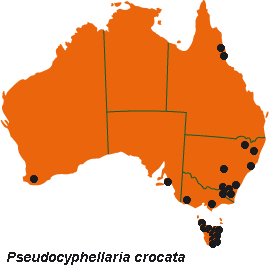



Australian Biological Resources Study
| Checklist of the Lichens of Australia and its Island Territories | ||
| Introduction | A–D | E–O | P–R | S–Z | Oceanic Islands | References | ||
| Pseudocyphellaria crocata (L.) Vain. | ||
| Hedwigia 37: 34 (1898); Lichen crocatus L., Mantissa 310 (1771). T: India, Koenig; holo: LINN 1273.137. | ||
| Thallus rosette-forming to irregularly spreading, loosely to closely attached, 5–10 (–20) cm wide. Lobes broadly rounded and ±plane to narrow, canaliculate, deeply laciniate and discrete from margins to centre, to complex-imbricate, 1–5 (–7) cm long, 5–10 (–35) mm wide; lobe margins entire to ragged-incised, wavy, sorediate; soralia punctiform to linear, often eroding to lower surface. Upper surface fawnish grey to glaucous or brownish yellow when dry, grey-blue to bluish brown when wet, plane, undulate, shallowly wrinkled to densely faveolate, occasionally patchily short-tomentose, maculate and sorediate, without isidia, phyllidia or pseudocyphellae. Maculae delicate, white, distinctly reticulate, following ridges and in faveolae (×10 lens). Soredia common, yellow, farinose to granular, laminal and marginal, randomly scattered in erose laminal soralia, or erupting from laminal ridges. Medulla white to patchily yellow-white. Photobiont Nostoc. Lower surface pale whitish to buff, tomentose from margins to centre. Pseudocyphellae scattered, yellow. Apothecia sessile, marginal and laminal, 0.3–2.5 mm diam.; disc pale to dark red-brown, epruinose; exciple pinkish, verrucose-areolate; epithecium dark yellow-brown to olive-brown, dissolving in K; hymenium colourless to pale straw-yellow; hypothecium opaque, yellow-brown to red-brown intensifying in K. Ascospores broadly ellipsoidal, 3-septate, 22.5–27 (–29.5) × 7–9 µm, olive-brown to dark brown. CHEMISTRY: Tenuiorin, methyl gyrophorate, gyrophoric acid, hopane-7β,22-diol (trace), hopane-6α,7β,22-triol, 7β-acetoxyhopane-6α,22-diol (trace), 6α-acetoxyhopane-7β,22-diol (trace), physciosporin (trace), norstictic acid (trace), stictic acid, cryptostictic acid, (trace), constictic acid, pulvinic acid, pulvinic dilactone and calycin. |  |
|
| A cosmopolitan species which occurs in south-western W.A., southern S.A., north-eastern Qld, eastern N.S.W., A.C.T., southern Vic. and Tas.; also Lord Howe Is. and Norfolk Is. It is an ecologically wide-ranging taxon in well-lit situations on decorticated wood, bark or rocks, often over bryophytes. The most prolific populations in Tas. are found on rocks in sclerophyll forest. | ||
| Galloway et al. (2001) | ||
| Checklist Index |
| Introduction | A–D | E–O | P–R | S–Z | Oceanic Islands | References |
This work is copyright. Apart from any use as permitted under the Copyright Act 1968, no part may be reproduced by any process without prior written permission from Australian Biological Resources Study. Requests and inquiries concerning reproduction and rights should be addressed in the first instance to Dr P. McCarthy. These pages may not be displayed on, or downloaded to, any other server without the express permission of ABRS.